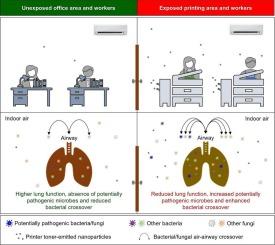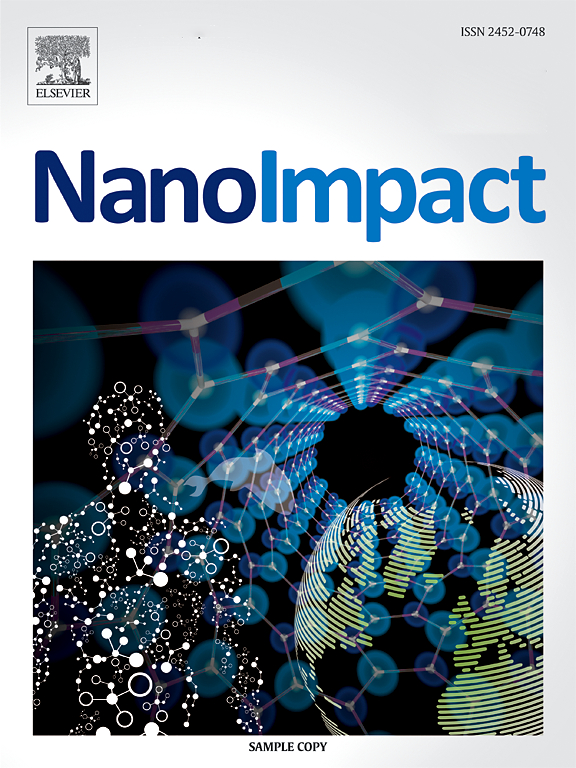在印刷设施中,职业暴露于打印机碳粉排放的纳米颗粒会影响空气和气道微生物群。
IF 5.5
3区 环境科学与生态学
Q2 ENVIRONMENTAL SCIENCES
引用次数: 0
摘要
在商业印刷设施中,工作场所接触打印机碳粉排放的纳米颗粒会对印刷车间的工人造成呼吸道健康风险,然而,其对环境和气道微生物群的影响以及这与工人健康的关系尚不清楚。为了调查这一点,我们前瞻性地评估了新加坡的五个印刷中心,从办公区和印刷地板收集空气样本,从办公室或印刷地板收集工作人员的呼吸道样本。所有标本均进行靶向扩增子测序以确定细菌组和真菌组谱。评估纳米颗粒暴露水平、空气和气道微生物组之间的关系。我们发现,在印刷设施中,纳米颗粒暴露与高暴露印刷区相对于低暴露办公区域的空气微生物组变化显著相关。确定了室内空气化学暴露的微生物组相关因素,主要是多环芳烃(PAHs)和微量元素。肺功能和气道微生物组受到纳米颗粒暴露的影响,打印地板工人表现出肺功能下降,与暴露水平无关,气道微生物组的特征是黄杆菌、卟啉单胞菌和念珠菌的富集。考虑到纳米颗粒暴露水平,对每个地点潜在的空气-气道微生物交叉的评估显示,印刷车间工人的细菌交叉显著增加,但真菌交叉没有增加。综上所述,本研究表明商业印刷设施和印刷工人的环境和气道微生物组发生了变化。需要进一步的研究来评估这种接触对健康的长期影响,包括在印刷设施设计和操作中进行微生物分析的可能性。本文章由计算机程序翻译,如有差异,请以英文原文为准。

Occupational exposure to printer toner-emitted nanoparticles at printing facilities influences air and airway microbiomes
Workplace exposure to printer toner-emitted nanoparticles at commercial printing facilities poses respiratory health risks to workers on the printing floor, however, its impact on environmental and airway microbiomes and how this relates to worker health remains unknown. To investigate this, we prospectively evaluated five printing centres in Singapore, collecting air samples from office areas and printing floors and airway specimens from workers stationed in office or printing floor areas. All specimens were subjected to targeted amplicon sequencing to determine bacteriome and mycobiome profiles. Relationships between nanoparticle exposure levels, air and airway microbiomes were assessed. We reveal that nanoparticle exposure at printing facilities was significantly associated with shifts in air microbiome profiles in high-exposure printing areas relative to low-exposure office areas. Microbiome correlates of indoor air chemical exposures, mainly polycyclic aromatic hydrocarbons (PAHs) and trace elements, were identified. Lung function and airway microbiomes were influenced by nanoparticle exposure where printing floor workers demonstrate reduced lung function, independent of exposure level, with airway microbiomes characterized by enrichment of Chryseobacterium, Porphyromonas and Candida. Assessment of potential air-airway microbial crossover at each site, accounting for nanoparticle exposure levels, reveals significant increases in bacterial but not fungal crossover in printing floor workers. Taken together, this study demonstrates altered environmental and airway microbiomes at commercial printing facilities and in printing floor workers. Further research is needed to assess the long-term health impacts of such exposure including the potential for microbial profiling in printing facility design and operation.
求助全文
通过发布文献求助,成功后即可免费获取论文全文。
去求助
来源期刊

NanoImpact
Social Sciences-Safety Research
CiteScore
11.00
自引率
6.10%
发文量
69
审稿时长
23 days
期刊介绍:
NanoImpact is a multidisciplinary journal that focuses on nanosafety research and areas related to the impacts of manufactured nanomaterials on human and environmental systems and the behavior of nanomaterials in these systems.
 求助内容:
求助内容: 应助结果提醒方式:
应助结果提醒方式:


